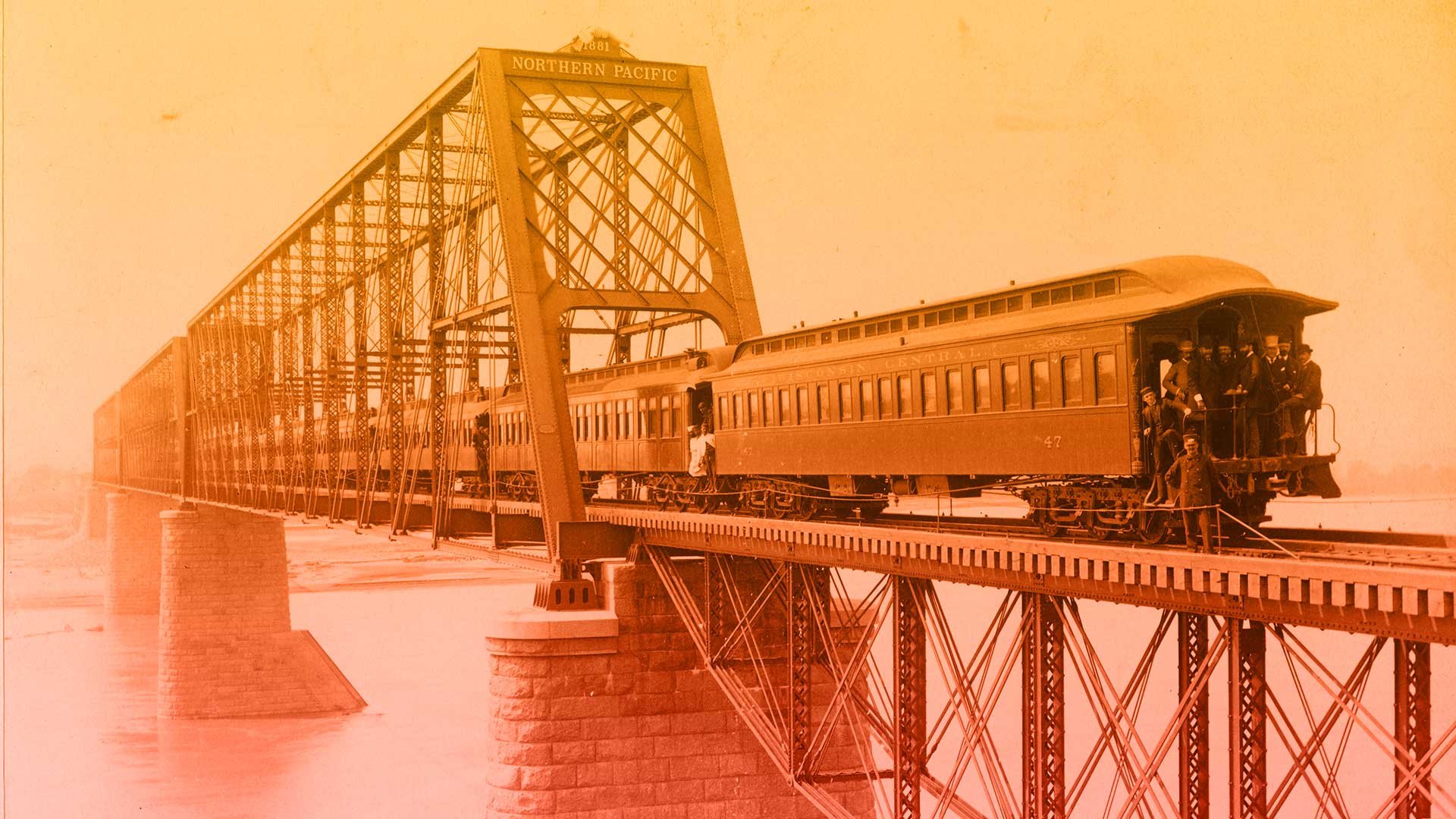
HISTORY
Built by the Northern Pacific Railroad Company from 1880-1883, the rail bridge represents the unprecedented industrial expansion of its era. As the first bridge to span the upper Missouri River, it contributed significantly to the growth of the rail roads, now known to be one of the greatest infrastructure projects in American history.
WHEN WAS THE HISTORIC NORTHERN PACIFIC RAIL BRIDGE COMPLETED?
It depends. Some historians claim it was built in 1882. Others say it was 1883. Well, both are right…sort of. The bridge we see today wasn’t built in a day. In March 1880, Northern Pacific President Frederick Billings hired consulting engineer George Shattuck Morison to design a bridge that would cross the Missouri between Bismarck and Mandan, Dakota Territory.
The final location of the crossing was selected in July, a direct route between the two communities, to minimize additional approach trackage and take advantage of favorable substructural conditions. Because the Missouri River was a thoroughfare for steamboat traffic, the design had to be a high bridge, with sufficient elevation for riverboat traffic to pass beneath. The major challenge was not the height, however, but the 3,000 foot width of the river at the high water mark. To narrow the river channel, an earthen dike was built extending from the west bank into the channel, constricting the river’s width to 1,000 feet. Today, the development known as Captains Landing Township is built on the infill downstream from that dike.
Morison’s design incorporated three 400-foot truss spans engineered to withstand a moving load of 2,000 pounds per linear foot. The trusses used a combination of structural steel and wrought iron. Bids for the manufacture of the trusses were let in January 1881. A massive ice jam and flood in March of 1881 caused significant damage to the west bank dike and prolonged the start of work on the substructure. In May, excavation for the east pier foundation was begun and a concrete footing was poured in September. On October 4, 1881, masons laid the first stone for the Bismarck Bridge.
In June the following year, construction was begun on the first 26 x 74-foot caisson, composed of 133,000 board feet of timber, 58,000 pounds of wrought iron bolts and rods, and 10,000 pounds of cast iron washers. The structure was towed into position by a transfer steamer where it was lowered to the riverbed. The work chamber was pressurized using two steam-powered air compressors housed in a barge above, and the wooden cribbing at the top of the caisson was filled with concrete upon which stonemasons began laying blocks of Minnesota granite.
The process was replicated for the third pier and work continued through the following winter. The final pier was constructed atop wooden piles, driven by a steam-powered pile driver, and by June of 1882, the last stone was set. Through the summer and fall, the three 400-foot steel and iron trusses were erected using wooden cribbing falsework to support them, and on October 7, 1882, the superstructure was completed. The bridge was tested a week later by running eight locomotives with a combined weight of more than 500 tons onto the spans. The bridge withstood the test and began service shortly after.
In January of 1883, the heavy iron ice breakers were mounted on the piers facing upriver, and in the spring of that year, the superstructure received two heavy coats of iron clad paint completing the work on the bridge. Almost ten years late and costing almost $1.1 million, the Northern Pacific had finally bridged the Missouri River at Bismarck.
The first week of September 1883 was notable for the amazing coincidence that the sitting president, Chester A. Arthur, crossed it on his way back to the White House from Yellowstone Park on September 2, that Sitting Bull crossed it on September 4 on his way to Bismarck from Mandan to participate in the laying of the cornerstone of the new territorial capitol, that former president Ulysses S. Grant crossed it on September 5 after the cornerstone ceremony in Bismarck on his way west to the last spike ceremony in Montana, and that Theodore Roosevelt crossed it on September 7 on his way west to the Dakota Badlands to hunt buffalo. The transcontinental line was completed on August 22, 1883, and the “last spike” ceremony was held two weeks later at Gold Creek, Montana on September 8.
In 1905, the original bridge spans were replaced with all-steel trusses that would support more than twice the weight of the old bridge superstructure. Those are the spans that exist today. During the placement of the new spans, Northern Pacific engineers designed wooden falseworks that not only supported the new spans, but also could accommodate the weight of passing trains that continued running all throughout construction.
Pier Construction
Piers 2 and 3 of the bridge, which lie within the river channel, were constructed using pneumatic caissons. This technique involved floating a hollow metal cylinder into place, and sinking it down into the mud. Once in contact with the river bottom, pumps were used to pressurize the chamber. Laborers would work in a dim, air-tight environment clearing the river bottom soils. As this was cleared, this would allow the caisson to further sink. This was continued until the bedrock of sufficient stability to maintain the pier was reached. The figure above shows workers in the caisson used to construct pier 2.
More in-depth information on the history of the bridge can be found in a document written by Ed Murphy here. A collection of historical photographs and images can be found here.
